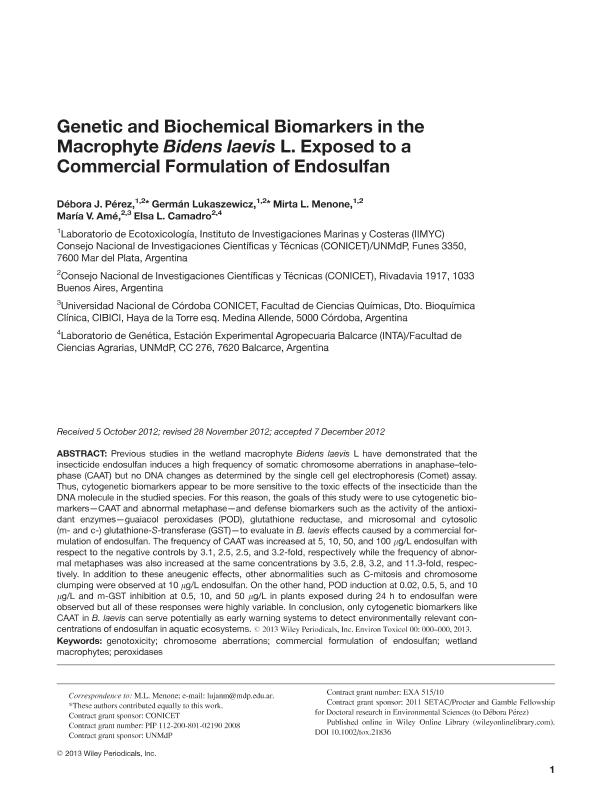Mostrar el registro sencillo del ítem
dc.contributor.author
Pérez, Débora Jesabel

dc.contributor.author
Lukaszewicz, Germán

dc.contributor.author
Menone, Mirta Lujan

dc.contributor.author
Amé, María Valeria

dc.contributor.author
Camadro, Elsa Lucila

dc.date.available
2022-12-07T12:57:13Z
dc.date.issued
2014-01
dc.identifier.citation
Pérez, Débora Jesabel; Lukaszewicz, Germán; Menone, Mirta Lujan; Amé, María Valeria; Camadro, Elsa Lucila; Genetic and biochemical biomarkers in the macrophyte Bidens laevis L. exposed to a commercial formula of endosulfan; John Wiley & Sons Inc.; Environmental Toxicology; 29; 9; 1-2014; 1063-1071
dc.identifier.issn
1520-4081
dc.identifier.uri
http://hdl.handle.net/11336/180487
dc.description.abstract
Previous studies in the wetland macrophyte Bidens laevis L have demonstrated that the insecticide endosulfan induces a high frequency of somatic chromosome aberrations in anaphase-telophase (CAAT) but no DNA changes as determined by the single cell gel electrophoresis (Comet) assay. Thus, cytogenetic biomarkers appear to be more sensitive to the toxic effects of the insecticide than the DNA molecule in the studied species. For this reason, the goals of this study were to use cytogenetic biomarkers-CAAT and abnormal metaphase-and defense biomarkers such as the activity of the antioxidant enzymes-guaiacol peroxidases (POD), glutathione reductase, and microsomal and cytosolic (m- and c-) glutathione-S-transferase (GST)-to evaluate in B. laevis effects caused by a commercial formulation of endosulfan. The frequency of CAAT was increased at 5, 10, 50, and 100 μg/L endosulfan with respect to the negative controls by 3.1, 2.5, 2.5, and 3.2-fold, respectively while the frequency of abnormal metaphases was also increased at the same concentrations by 3.5, 2.8, 3.2, and 11.3-fold, respectively. In addition to these aneugenic effects, other abnormalities such as C-mitosis and chromosome clumping were observed at 10 μg/L endosulfan. On the other hand, POD induction at 0.02, 0.5, 5, and 10 μg/L and m-GST inhibition at 0.5, 10, and 50 μg/L in plants exposed during 24 h to endosulfan were observed but all of these responses were highly variable. In conclusion, only cytogenetic biomarkers like CAAT in B. laevis can serve potentially as early warning systems to detect environmentally relevant concentrations of endosulfan in aquatic ecosystems.
dc.format
application/pdf
dc.language.iso
eng
dc.publisher
John Wiley & Sons Inc.

dc.rights
info:eu-repo/semantics/openAccess
dc.rights.uri
https://creativecommons.org/licenses/by-nc-sa/2.5/ar/
dc.subject
CHROMOSOME ABERRATIONS
dc.subject
COMMERCIAL FORMULATION OF ENDOSULFAN
dc.subject
GENOTOXICITY
dc.subject
PEROXIDASES
dc.subject
WETLAND MACROPHYTES
dc.subject.classification
Oceanografía, Hidrología, Recursos Hídricos

dc.subject.classification
Ciencias de la Tierra y relacionadas con el Medio Ambiente

dc.subject.classification
CIENCIAS NATURALES Y EXACTAS

dc.title
Genetic and biochemical biomarkers in the macrophyte Bidens laevis L. exposed to a commercial formula of endosulfan
dc.type
info:eu-repo/semantics/article
dc.type
info:ar-repo/semantics/artículo
dc.type
info:eu-repo/semantics/publishedVersion
dc.date.updated
2022-12-07T11:26:54Z
dc.journal.volume
29
dc.journal.number
9
dc.journal.pagination
1063-1071
dc.journal.pais
Estados Unidos

dc.journal.ciudad
New York
dc.description.fil
Fil: Pérez, Débora Jesabel. Universidad Nacional de Mar del Plata. Facultad de Ciencias Exactas y Naturales. Departamento de Ciencias Marinas. Laboratorio de Ecotoxicología; Argentina. Consejo Nacional de Investigaciones Científicas y Técnicas. Centro Científico Tecnológico Conicet - Mar del Plata. Instituto de Investigaciones Marinas y Costeras. Universidad Nacional de Mar del Plata. Facultad de Ciencias Exactas y Naturales. Instituto de Investigaciones Marinas y Costeras; Argentina
dc.description.fil
Fil: Lukaszewicz, Germán. Universidad Nacional de Mar del Plata. Facultad de Ciencias Exactas y Naturales. Departamento de Ciencias Marinas. Laboratorio de Ecotoxicología; Argentina. Consejo Nacional de Investigaciones Científicas y Técnicas. Centro Científico Tecnológico Conicet - Mar del Plata. Instituto de Investigaciones Marinas y Costeras. Universidad Nacional de Mar del Plata. Facultad de Ciencias Exactas y Naturales. Instituto de Investigaciones Marinas y Costeras; Argentina
dc.description.fil
Fil: Menone, Mirta Lujan. Universidad Nacional de Mar del Plata. Facultad de Ciencias Exactas y Naturales. Departamento de Ciencias Marinas. Laboratorio de Ecotoxicología; Argentina. Consejo Nacional de Investigaciones Científicas y Técnicas. Centro Científico Tecnológico Conicet - Mar del Plata. Instituto de Investigaciones Marinas y Costeras. Universidad Nacional de Mar del Plata. Facultad de Ciencias Exactas y Naturales. Instituto de Investigaciones Marinas y Costeras; Argentina
dc.description.fil
Fil: Amé, María Valeria. Consejo Nacional de Investigaciones Científicas y Técnicas; Argentina. Universidad Nacional de Córdoba; Argentina
dc.description.fil
Fil: Camadro, Elsa Lucila. Instituto Nacional de Tecnología Agropecuaria. Centro Regional Buenos Aires Sur. Estación Experimental Agropecuaria Balcarce; Argentina. Consejo Nacional de Investigaciones Científicas y Técnicas. Centro Científico Tecnológico Conicet - Mar del Plata; Argentina
dc.journal.title
Environmental Toxicology

dc.relation.alternativeid
info:eu-repo/semantics/altIdentifier/url/http://onlinelibrary.wiley.com/doi/10.1002/tox.21836
dc.relation.alternativeid
info:eu-repo/semantics/altIdentifier/doi/http://dx.doi.org/10.1002/tox.21836
Archivos asociados
